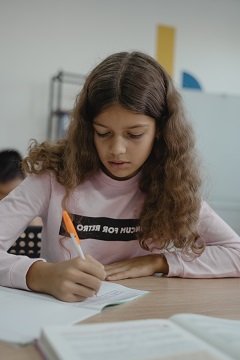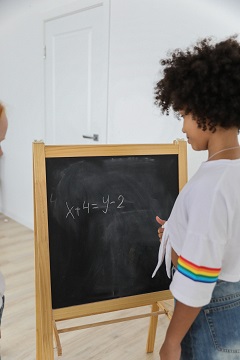WHY DO SOME CHILDREN DO BADLY IN SCHOOL?
– Lugina Miranda

Neha, a 10-year-old girl was brought for counseling by her mother due to her inability to copy from the black board adequately. She needs a lot of coaxing to study and insists that her mother sits beside her continuously while studying and doing her homework. She forgets her answers and has poor handwriting.
Rohan, an 8-year-old studying in English Medium, writes ‘b’ for ‘d’ and ‘p’ for ‘q’. He omits letters and words and mixes upper and lower case. While reading Rohan guesses words based on the first letter of the word and substitute it with other words. In mathematics he confuses ‘+’ and ‘x’ signs and reverses numbers. Eg: ‘6’ as ‘9’and ’21’ as ‘12’. According to Rohan’s parents, he is better in oral work as compared to written work. He is not able to speak fluently in English, as the language spoken at home is Kannada.
A 9-year-old boy Rohit is disruptive, inattentive, distracted, will not sit in place, disturbs others, is always on the go, will not learn, cannot read and cannot form the alphabets. He is very bright, good at oral work, has excellent language skills and general knowledge. Because of his behavior, he had to change three schools. Parents also find it difficult to handle his behavior at home.

Education is the key to the progress of any society. Though we have adequate schools in our state and country this has not ascertained that all children will learn. Many children either drop out of school early or get pushed up the class ladder through a system of ‘rote learning’ and ‘rote production’ at examination without really learning. Eventually they are unable to cope in school and finally give up studying.
There are several reasons why children may have poor academic performance. The causes may be in the environment such as crowded classrooms, poor method of teaching, family conflict or within the child – like ill health, hearing and vision problem and various disabilities. However most common causes of learning difficulties in children are- Specific Learning Disability (SLD), Second Language Learning Difficulties, Low Intelligence Levels, Hearing and Vision Deficits and Other Disabilities.


Specific Learning Disability (SLD)
SLD is a neurological disorder, which manifests as difficulty in reading, spelling, writing, speaking, listening and computing (mathematics); in children who otherwise seem bright. These children have difficulty in processing, storing and producing information. Research in neuroscience now tells us that it is due to differences in brain structure, connections between brain cells and its function.
The incidence of SLD is around 10-15% thus in a class of 50-60 children, there will be at least 5-7 who will have SLD. Usually these children for no fault of theirs are blamed and labeled as lazy, stupid, slow or even mentally retarded. Parents of these children say, “he/she is clever, but lazy, he/she can remember everything on T.V.. If he puts more effort he can pass- instead he always shows interest in play”. The milder ones manage to scrape through exams with complete loss of self-esteem and belief in their abilities and completely unaware of their great potential. SLD is not caused by poor parenting or teaching, laziness or lack of motivation.

This does not mean the brains of these individuals with SLD are in any way inferior. On the contrary, they are just different and often gifted in other ways. Many famous people including Albert Einstein, Walt Disney, Alexander Graham Bell, Leonardo da Vinci, Nelson Rockfeller and Winston Churchill were also learning disabled.
Sometimes some early signs like reversing letters and numbers may be seen in very young children as the brain is not fully matured. Hence, SLD is not diagnosed before the age of 7 – 8 years. Early detection helps to intervene with remedial teaching methods and prevent more serious problem. There are many early warning signs such as delayed speech, difficulty in pronunciation, drawing, coloring, buttoning, lacing, cutting, difficulty in identifying colors, letters, numerals, problem in sequencing and counting and restlessness and short attention span.


Second Language Learning Difficulties
Language dilemma is seen in children, when they are forced to learn in a non-dominant language, which is not their mother tongue. We commonly see children whose mother tongue is Konkani, Kannada, Tulu or any other vernacular Indian language but who have to learn in the English Medium. There is lack of practice in speaking English at home or in school. All these result in poor comprehension of English. As the teacher struggles to ‘complete the portion’, the situation is worsened by hurried instructions in school, based only on textbooks with a focus on rote learning and visual memory. Children are expected to master the spellings of words ‘by heart’ and children are forced to remember answers to question and even memorize essays, which they cannot understand. If they forget the words in a sentence, they are unable to frame their own sentences to answer the questions. A reliance on rote memory to spelling and comprehension is the worst way of teaching a language. It is humanly not possible for children to sustain the model of language learning. Therefore, the outcome is that many of our children cannot understand, read and write second language and fail miserably.

Low Intelligence Level
Children who are slow learners or have mental retardation will not be able to cope with the curriculum. They can learn, though may be not as easily or quickly as other children of their age. They may not possess intellectual skills but they could have other talents and the capacity to develop these if the right support is provided in time.
However, it must be remembered that these children too need intellectual stimulation and are capable of learning much. In fact, because they do not learn in the classroom, many of them present with difficult behaviors out of sheer boredom and a feeling of inadequacy. These could range from sitting quietly with no class participation to aggressive, disruptive behaviors, which are extremely difficult to handle.


Problem with paying attention
Children who suffer from a condition known as Attention Deficit Hyperactivity Disorder (or ADHD) show hyperactivity and restlessness, inattention leading to distraction and impulsivity where they do not think of the results of their actions, thereby getting into trouble with teachers and peers constantly. Many of them also have associated learning problems that further worsens their school performance. It is important to remember that these children are not misbehaving or failing on purpose and many of them feel sad, defeated and frustrated.
Many children with learning difficulties may not pay attention in class since they do not follow what the teacher is explaining or cannot copy from the board. In these instances, the inattention is secondary to the learning difficulty.

Hearing & Vision Deficits
Since our ears and eyes are so crucial to getting input into our brains for processing and learning, it is obvious that children with problems in hearing and vision will have learning difficulties. These problems can be corrected with various aids and the student’s learning can be improved.
Other Disabilities
Problems such as autism (where the child has difficulties with language, social interaction, repetitive behaviors and cerebral palsy (difficulty in use of muscles due to poor control from the brain) can also cause learning problems in the classroom. However, with adaptations to the curriculum, teaching methods and classroom environment these children can also learn.


Get Help Early
When a child is doing badly in school, it is important that help is given as soon as possible. Very often, there is long delay between detection and intervention for learning problems. Initially the parents are in denial stage to accept that their child is struggling to learn and fear that their child may be labeled for life. It is hard for teachers to convince the parents that help is needed. Seeking help and recognizing the signs of learning problems can mean the difference between success and failure in school. If children receive appropriate help early, most of them will learn. When help is delayed, it becomes harder for children to catch up. We must help the child understand that he/she just learns differently.
